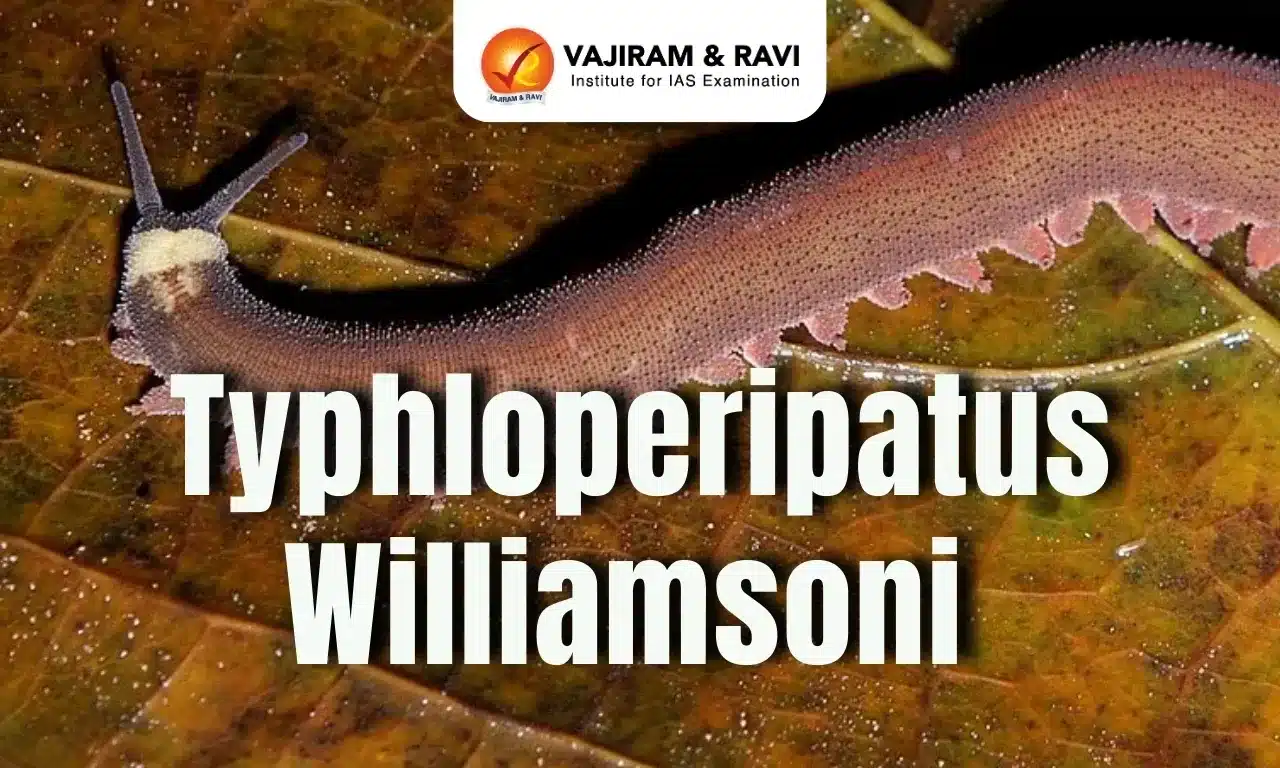Typhloperipatus williamsoni Latest News
A team of researchers recently reported rediscovering a long-lost species of the velvet worm (phylum Onychophora), named Typhloperipatus williamsoni, one of the oldest living fossils in the world, after 111 years.
About Typhloperipatus williamsoni
- It is an ancient velvet worm species (phylum Onychophora), one of the oldest living fossils in the world.
- Onychophora is a very old group, easily older than 350 million years.
- It has only two families and not more than 200 species. The diversity is very less.
- These were evolving almost simultaneously with dinosaurs. When the mass extinction happened, probably a lot of them were wiped out.
- What we see today is mostly those species which escaped extinction.
- T. williamsoni was rediscovered after 111 years from the Siang Valley in Arunachal Pradesh.
- T. williamsoni was first collected during the “Abor expedition” by Stanley Kemp, the erstwhile superintendent of the Indian Museum, Calcutta, and his team in December 1911 in Siang Valley.
- Since Kemp’s discovery, there have been no documented records of it from India.
- The molecular data from T. williamsoni indicated that South Asian onychophoras split from their neotropical (Central and South America), including southern parts of Mexico and the Caribbean) and only African relatives around 237 million years ago.
- Interestingly, the Asian onycophora were found to have no relatives in Australian onychophoras.
- This is unusual given that invertebrates found in Southeast Asia and India are usually related to those in Australia.
- Asian Onychophora is one of the few exceptions to this relationship.
Typhloperipatus williamsoni FAQs
Q1. Are velvet worms poisonous to humans?
Ans. Velvet worms (Onychophora) are not poisonous or dangerous to humans.
Q2. Typhloperipatus williamsoni belongs to which phylum?
Ans. Onychophora
Q3. Where was T. williamsoni rediscovered?
Ans. Siang Valley, Arunachal Pradesh
Source: TH
Last updated on December, 2025
→ Check out the latest UPSC Syllabus 2026 here.
→ Join Vajiram & Ravi’s Interview Guidance Programme for expert help to crack your final UPSC stage.
→ UPSC Mains Result 2025 is now out.
→ UPSC Notification 2026 is scheduled to be released on January 14, 2026.
→ UPSC Calendar 2026 is released on 15th May, 2025.
→ The UPSC Vacancy 2025 were released 1129, out of which 979 were for UPSC CSE and remaining 150 are for UPSC IFoS.
→ UPSC Prelims 2026 will be conducted on 24th May, 2026 & UPSC Mains 2026 will be conducted on 21st August 2026.
→ The UPSC Selection Process is of 3 stages-Prelims, Mains and Interview.
→ UPSC Result 2024 is released with latest UPSC Marksheet 2024. Check Now!
→ UPSC Prelims Result 2025 is out now for the CSE held on 25 May 2025.
→ UPSC Toppers List 2024 is released now. Shakti Dubey is UPSC AIR 1 2024 Topper.
→ UPSC Prelims Question Paper 2025 and Unofficial Prelims Answer Key 2025 are available now.
→ UPSC Mains Question Paper 2025 is out for Essay, GS 1, 2, 3 & GS 4.
→ UPSC Mains Indian Language Question Paper 2025 is now out.
→ UPSC Mains Optional Question Paper 2025 is now out.
→ Also check Best IAS Coaching in Delhi

















